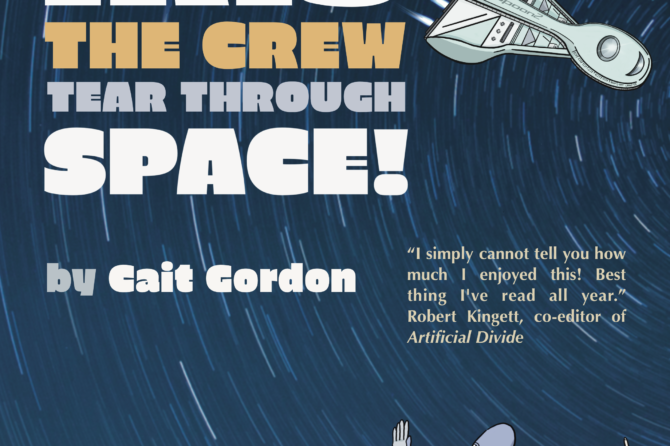
When I attended my first convention—my fannish inauguration, if you will—in 1975, Roger Elwood (1943-2007—Figure 1*) had already begun to make a splash in science fiction; by 1974 (inclusive), according to Jonathan Strahan—figures supplied by Bill Contento, compiler of the Locus database—he’d already published some 55 anthologies in that field over the previous ten years, with the bulk being published in 1973 and 1974 (19 and 23 respectively)! Regardless of the quality of the anthologies, that’s an impressive number of anthologies for such a short period, comprising about 25% of the published SF anthologies for those two years. At that time I was receiving a lot of SF review books, and I had quite a number of Elwood anthologies in my collection—mostly hardcover.
Now in those days I was in my late ‘20s and had been reading SF for most of that time, although it wasn’t my sole reading matter, but it formed the bulk of my reading matter. At that age I was still assimilating material, and hadn’t really formed any critical opinions other than “I like this but I don’t like that”; certainly not enough opinion to say definitively “this is good SF” or “this is bad SF.” (When I’m reviewing books for this column, dear reader, I try not to—unless a certain book, movie or TV show is really, really good or bad—make too many value judgments. So aside from providing lots of reading material, I was aware of Elwood’s compiling prowess, but hadn’t really thought much about the quality. At my first convention—which is also the first time I met Elwood—part of the attendees’ packet was a paperback book, the so-called “Number zero” of Laser Books’ coming SF series, edited by this same Roger Elwood. This book was Seeds of Change by Thomas F. Monteleone. I understand it was also given away at some bookstores. Up until #37, when you subscribed or filled out a survey in the back of a Laser book, you also got a free copy.

Now, Harlequin Books, in Don Mills, Ontario (Canada), was not known at this time for publishing anything except romance books, including the well-known “Gothic romance,” featuring cover images of women in whispy white negligees standing in front of ruined castles with one lighted window; sometimes a horse and carriage would also feature in the picture. (I can’t say for sure what was inside; the images never intrigued me enough to make me want to read one.) By the mid-1970s, Harlequin had published hundreds; possibly tens of thousands—my landlady in 1973 had a giant collection that she kept in boxes out in the barn. Oddly enough, some of the most collectible early Harlequins were SF/F, but I was only able to find one: Figure 3 – A reprint of John Russell Fearn’s The Golden Amazon (1958). In those days, Harlequin published lots of mysteries and hard-boiled ‘tec novels, by such writers as Edgar Wallace and Agatha Christie.

But apparently, in 1975, Roger Elwood talked Harlequin into a science fiction line; and Laser Books was born. In all, Laser published 58 books—for a couple of years at the rate of 3 a month!—including the first, unnumbered giveaway. By the time the series ended, readers were beginning to think that perhaps Elwood’s name on a book was not a guarantee of quality. (On Wikipedia, Teresa Nielsen-Hayden is quoted as having more than a few things to say about Elwood’s influence on SF anthologies, and the quality thereof. On the other hand, some bloggers, like Senski, have defended Elwood.)
Was the quality high? On average, the books were merely average, in my opinion. There were no real low spots, but there were a few quite high spots, including Ray F. Nelson’s Blake’s Progress (also now known as Tyger! Tyger!), Tim Powers’s The Skies Discrowned, and Aaron Wolfe’s Invasion. (You might know him by his real name: Dean R. Koontz.) There were other usually good writers, like Jerry Pournelle, J. F. Bone, J.T. McIntosh (no offense to any writers I’ve left off the list; I’m not going into a giant amount of detail on this). Many people who read Lasers were unaware that they were heavily edited—Bowdlerized to some extent—to conform to Harlequin’s general policies. Tim Powers–according to Wikipedia–was highly put out by the changes to his manuscript. (And there’s also a possibility that Elwood withheld money owed to some authors; here we will adhere to De mortuis nil nisi bonum—of the dead say nothing but good.) To the general fan, however, I would venture to say that the majority of Laser titles would not give offense to any puppies, sad or otherwise.
Why do I bring up puppies? Well, as I understand it, one of their mandates—and at this point I’m not distinguishing between sad and rabid ones—is to bring back the “good old stuff”—that is, stuff that’s not too “literary,” stuff that would be at home in the 1950s, before there was all this Politically Correct writing going around (that there’s sarcasm, folks). (I should also point out that a number of Lasers were written by women—Juanita Coulson, Kathleen Sky and Joan Hunter Holly, for example, as was a lot of the authentic Good Old Stuff. Who could deny that women like Leigh Brackett and Andre Norton wrote Good Old Stuff back in The Day?) Well, if “message fiction” and “literary fiction” are the Bad Categories, then for the most point, Laser books would have been lauded by the small dogs. I, personally, would call most of them “a fun read” and leave it at that.

A good buy for under a buck—at least at the beginning; by #37, The Meddlers, by J.F. Bone, the price had gone up to $1.25, where it stuck until the end. Interestingly enough, the whole series underwent a redesign, as shown in Figure 4. The black curved “frame” for the Kelly Freas cover—all covers for the Laser series were painted by Frank Kelly Freas—expanded to just under the logo, and the title was dropped out of the black, with the author’s name moving down into the actual graphic. The Roger Elwood attribution, which had varied from “Series edited by Roger Elwood” to “General Editor Roger Elwood” was moved to the back cover—possibly because Harlequin was realizing that at that point, Elwood’s name might not actually be a draw for SF/F fans. (In checking my collection and looking at the titles, I now realize that there was ostensibly no fantasy in the series at all.)
Up to #37, The Freas covers—all of them at least workmanlike, although there were a few that stood out; for example, the Gene DeWeese title shown in Figure 4 was quite striking—had all been confined to the frame on the cover, then repeated—vignetted—on the back cover; starting with #37, Kelly began doing wraparound covers. (At the worldcon MidAmericon (Kansas City, Kansas—in 1976), Laser held a draw, and the prize was to have Kelly paint your portrait and put it on the cover of a Laser book. I don’t know who won; or indeed whether the winner got on a Laser cover, but I have a vague memory of Kelly telling me who did, some years later. My guess is that the winner also received the portrait of themselves—a rare treat indeed!)
I doubt that Kelly did a wraparound for the same money he did a vignette cover; if nothing else, his then wife Polly Freas, who was vigilant both on Kelly’s physical and financial health, would have seen to it that he got more money for the wraparounds. Polly was a diminutive woman with a will of iron; I met her on more than one occasion and liked her immensely.
(After Polly’s death from cancer, Kelly remarried; his widow, Dr. Laura Brodian Freas, is having a birthday today! Be sure to drop by her Facebook page and wish her a happy birthday.) Kelly himself was a gentleman of the old school, gracious to a fault; his oil portrait of me hangs on my office wall—and signed with his old KF “bug” that he used to use on Astounding covers; said portrait paid for by E.E. “Doc” Smith’s daughter, Verna Smith Trestrail, a good friend until her death. He was a consummate illustrator; my wife, the Beautiful and Talented Lynne Taylor Fahnestalk said, after we spent some time in Kelly and Laura’s room, talking art and other things, at the Winnipeg Worldcon (“ConAdian”), “I learned more in that time with Kelly than I did in four years of art school.”

But back to the books. Because of limited time—do you know how long it takes to read 57 books?—and space, I’m not going to attempt to review any of the Lasers here. Just note that if you’re at all intrigued, many of them are available on eBay or Amazon.com for reasonable amounts. (#57, Shadow on the Stars, by Robert B. Marcus Jr. was never distributed to bookstores; it was available to subscribers only. Amazon describes it as very rare and copies are, apparently, going for $45 to $100 US.) My purpose here is to bring some SF/F and SF/F-related stuff to readers who might otherwise not be aware. (And in the future I will be doing a column on Kelly Freas, who was often called “The Dean of SF Illustrators.”)

Okay, here’s a fun thing: I just realized I have three(!) good to near-mint copies of Gordon Eklund’s Serving In Time (#6). I will give away (pay postage and all) one copy to each of two people; “like” my column on Facebook (in any of the two FB groups I post to or my home page) and send me a message with your name/snail mail (private message, please—we don’t want your information all over Facebook) telling me why you want/need/deserve this book and I’ll draw from all messages received over the next six days. Winners will be announced next week.
*Figure 1 is taken off teh interwebz; since this photo doesn’t match the Roger Elwood of my memories (well, it has been 40 years!), and I can’t remember if I took a photo of him in the late ‘70s, this will have to do. If it isn’t Roger, my apologies to whomever it really is.
I really am interested in your opinion of this column, even if you didn’t like it. If you have anything to say about it, good or bad, please post your comment here—it’s easy (and you can even sign up to get automatic notifications of new columns!). Or you could comment on Facebook; I post links every Friday when a new column comes out. My opinion is, as always, my own, and doesn’t necessarily reflect the views of Amazing Stories or its owners, editors, publishers or other bloggers. See you next week!











As it turns out, I was just checking on the Laser Book series. I am missing 6 from the grand total of 58. I bought my first copy in 1975 and then purchased them as they became available…except for when I was going through basic training (Army) in 1976. Still have them, they’ve moved around the world with me and I still enjoy reading them from time to time.
Despite the fact that they were, for the most part, quickly written for a flat $5K (if my memory is correct), there are some excellent books in the Laser series. Glad you’re still enjoying them, Dave!
just found this article, I was looking for more information on Laser Books since I just bought a collection. Great information! And you blew my mind with the Andre Norton is a woman LOL, I just always imagined a man.
Hey, Gregory: good grief, I didn’t know anyone was still on AOL.COM! I remember when the discs (first floppies, then CDs) were everywhere! Glad you found the information useful. Let me know how you liked the books and if you found any that stood out for you. Yes, us old-timers all knew that Andre Norton was a woman; in fact, had I not been a laggard, I would have written a book with her, but alas! She died while I was still dithering about the plot (it was to be a sequel to “Catseye,” and the second book in a trilogy.) I enjoyed such books (not Lasers) as “Sea Siege,” and “Daybreak 2250 A.D.,” and “The Sioux Spaceman.”
I can remember reading about 4 plus books years ago,when I was in the Royal Navy and then they were hard to get hold of which was a real shame as I loved them I was in my teens and that must have been nearly 40 years ago. Shame they don’t seem to get the same people writing these types I liked the column I have just read. And it has made me want to look for these books again. I doubt I will have much chance in the uk but I will try. I will probably have to look on the stateside eBay as I did with the Perry rhodan series.
Andy h
Sorry, Andy, I’d send you a couple, but I think they’ve all been sent to thrift stores for other people’s reading pleasure!
Steve Thanks for the thought
I am sure I will find some eventually . These books I read just transported me to other places( I was obout 17 at he time ) it was such a shame that there was only a limited few in the UK at the time. I am sure that a job lot will come up at some time on the Internet. Second hand UK book shops don’t seem to have these. But I will keep looking.
Well, it’s now a couple of years since this column was published, and nobody wanted the Lasers, so they have been rehomed at one of our local thrift stores. I hope someone is pleasantly surprised when they find them!
Fascinating story, Steve. I never came close to opening a Laser Book — in my corner of fandom, Roger Elwood’s reputation as an SF editor was somewhat south of Ray Palmer’s. Groff Conklin he was not. It didn’t help that I and my friends all knew the novels were bowdlerized and heavily edited to fit into Laser’s 190-page format. Had I ever seen even one positive review of a Laser Book, I might have tried one sometime.
One bit of criticism: There was no need to drag the Puppies controversy into a story about books published nearly 40 years ago. By doing so, you plopped a turd into an otherwise savory punch bowl.
Thanks, Gene–Try the Nelson or Powers stories mentioned. You might like ’em.
I also enjoyed your discussion of Kelly Freas, who is my all-time favorite SF illustrator. I was lucky to meet him at a con in Detroit in 1975 and wound up driving him to the airport. A true gentleman with awesome talent. I didn’t get a portrait out of it, though. DRATS!
Nice column, Steve, and thank you for it. But the 1976 worldcon was not held in Kansas City, Kansas.
Thanks, Dave–I sat here trying to remember WHICH Kansas City it was in; should have Googled it. Memory becomes increasingly fallible after a while.